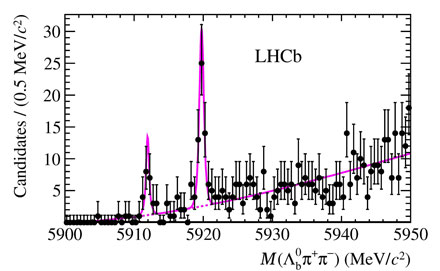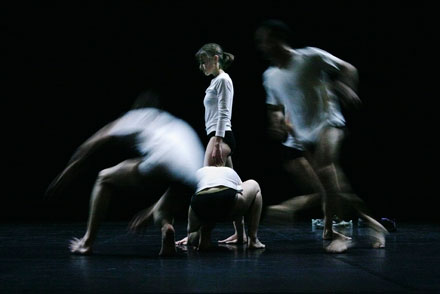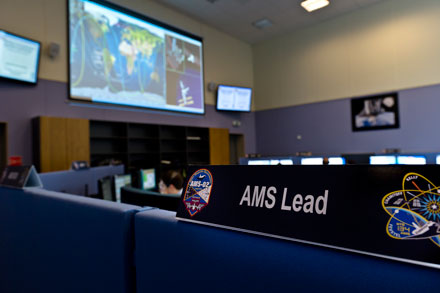31.05.2012: LHC data harvest continues in earnest

Experimental physicists from the ATLAS experiment discussing their work at CERN. More data means more analysis work for physicists.
The Large Hadron Collider is busy supplying the experiments with an impressive number of collisions at an energy of 4 TeV per beam. After just 2 months of beam this year the LHC has already delivered 7 inverse femtobarns of data – more than half the entire 2011 run.
An inverse femtobarn is a measure of integrated luminosity – or the amount of data that experiments can gather. An inverse femtobarn represents about 100 million million collisions.
The accumulation of large amounts of data from collisions is crucial to increasing the chances of discoveries at the LHC.
More information
25.05.2012: Back from space to CERN

ESA astronaut Christer Fuglesang (right) gives the neutralino to CERN Director for Research Sergio Bertolucci (left).
Christer Fuglesang, ESA astronaut and former CERN scientist, payed a visit to CERN on 24 and 25 May. In addition to presenting scientific research onboard the International Space Station, he brought with him a rather unusual gift - a fluffy yellow soft-toy representing the neutralino, a particle searched for at the LHC. Neutralinos are one of the particles that could make up the missing dark matter in the Universe. Just like the hypothetical particle it is named after, this fluffy toy has also been zipping through space, in this case accompanying Christer Fuglesang on-board the space shuttle Discovery for the mission STS-128.
Find out more
- CERN Bulletin: The space-travelling neutralino is back at CERN
- Video: CERN News
- Colloquium: Physics research on the International Space Station
- Quantum Diaries: CERN's prodigal neutralino comes back from outer space
23.05.2012: CERN's first choreographer in residence to give public lecture
The Moebius Strip © Cie Gilles Jobin 2007 (Image: Dorothée Thébert)
Swiss choreographer Gilles Jobin and his inspiration partner João Pequenão will give a public lecture this evening in the Globe of Science and Innovation at CERN.
In March Jobin was awarded the first Collide@CERN-Geneva prize in Dance and Performance for his proposal to use interventions and dance to explore the relationship between mind and body at the world's largest particle physics laboratory. Pequenão, who produces science visualizations at CERN, will work with the choreographer during his 3-month residency.
The presentation will be webcast: tune in here.
Doors open at 6.30pm CET, with presentations at 7pm.
Find out more
- Arts@CERN
- Want to attend the event? To make a reservation contact the Arts@CERN team or call +41 22 766 2109
22.05.2012: AMS reaches 17 billion cosmic-ray events
Physicists monitor the AMS-02 detector from the Payload Operation Control Center at CERN (Image: CERN)
On 16 May last year Space Shuttle Endeavour made its final flight, carrying the Alpha Magnetic Spectrometer (AMS-02) to the International Space Station (ISS). AMS-02 is a space-based particle-physics detector that operates as an external module on the ISS. By detecting and analyzing cosmic rays, AMS-02 is addressing some of the mysteries of modern physics, such as the questions of dark matter and antimatter.
Experts from the AMS collaboration operate the detector round the clock from the Payload Operation Control Center, a facility on the CERN site with a direct link to the ISS. Since its launch, AMS-02 has recorded 17 billion cosmic-ray events at energies exceeding 10 TeV.
The crew of STS134 – the Space-Shuttle mission that brought AMS to space – will visit CERN on 25 July this year.
Find out more
16.05.2012: LHCb discovers two excited states for the Λb beauty particle

The new excited states show clear signals at masses of 5912 MeV/c2 and 5920 MeV/c2 (Image: LHCb collaboration)
The Large Hadron Collider beauty (LHCb) experiment at CERN today announced that it has observed two new excited states of the Λb beauty baryon. Though the Standard Model of particle physics predicts the existence of these new states, this is the first time they have been confirmed in an experiment.
Baryons are subatomic particles whose mass is equal to or greater than that of a proton. Like protons and neutrons, the Λb beauty baryon is composed of three quarks. In Λb these are up, down and beauty quarks.
LHCb physicists found the signals for the Λb particlesin a sample of about 60 trillion proton—proton collisions which were delivered by the LHC operating at a centre-of-mass energy of 7 TeV in 2011. They measured the masses of the new excited states as 5912 MeV/c2 and 5920 MeV/c2 respectively - over five times greater than the mass of a proton or neutron.
The result adds to a growing list of discoveries at CERN in recent months. Last month the Compact Muon Solenoid (CMS) experiment observed a new excited state for the Ξb beauty baryon, and back in December 2011 ATLAS detected a new "quarkonium state" containing a beauty quark bound with its antiquark.
Find out more:
LHCb result
Other recent discoveries
14.05.2012: CERN welcomes its first choreographer in residence

The Moebius Strip © Cie Gilles Jobin 2007 (Image: Dorothée Thébert)
Space, time and gravity are under the cultural spotlight at CERN this month with the arrival of Gilles Jobin, the laboratory's first choreographer in residence and winner of the Collide@CERN Geneva prize, which is supported by the Canton and City of Geneva. Jobin is an internationally renowned Swiss choreographer with a company in Geneva. His CERN inspiration partner for his three-month residency at the laboratory will be the multi-media producer and visualisation specialist, João Pequenão, who studied physics at the University of Lisbon.
Find out more
09.05.2012: CERN computing looks to the future
![[IMAGE]](../features/120509_GRID.jpg)
The Worldwide LHC Computing Grid (pictured: Tier-0 servers at CERN) will see increased capacity and development (Image: CERN)
It's been an exciting week for computing at CERN.
On Tuesday CERN signed a contract with the Wigner Research Centre for Physics in Budapest, Hungary, for an extension to the CERN data centre. Under the new agreement, the Wigner Centre will host CERN equipment to extend the capabilities of the Worldwide LHC Computing Grid (WLCG) – a global computing system organized in tiers, with its central hub, Tier-0, at CERN. Tier-0 provides some 30 petabytes (PB) of data storage on disk, and includes the majority of the 65,000 processing cores in the CERN Computer Centre. The Wigner Centre will extend this capacity with 20,000 cores and 5.5 PB of disk data, which will double after 3 years.
And today CERN launched the fourth phase of CERN openlab – a unique public-private partnership between CERN and leading information-technology companies. The initiative brings together science and industry to develop advanced IT systems to cope with the computing challenges related to the Large Hadron Collider. This fourth phase of the intiative will address cloud computing, business analytics, next-generation hardware, and security for network devices.
Computing is a crucial part of CERN's activities. Initiatives like these will help physicists deal with the torrent of data expected as the LHC reaches higher intensities and energies in the coming years.
Find out more
2 May
Forty years of the PS Booster
![[IMAGE]](../features/120502_PS_Booster.jpg)
The Proton Synchrotron Booster in October 1972, just four months after being switched on for the first time (Image: CERN)
The Proton Synchrotron (PS) Booster – a key accelerator in the CERN complex – is 40 years old this month.
The accelerator is made up of four superimposed synchrotron rings that receive beams of protons from the linear accelerator (Linac) at 50 MeV and accelerate them to 800 MeV for injection into the Proton Synchrotron (PS).
Before the Booster received its first beams on 26 May 1972, protons were injected directly from the Linac into the PS, where they were accelerated to 26 GeV. The low injection energy of 50 MeV limited the number of protons the PS could accept. The Booster allows the PS to accept an order of magnitude more protons, which greatly enhances the beam's utility for experiments.
Find out more
27.04.2012: CMS discovers new particle – Meet the Ξb*0 beauty baryon
![[IMAGE]](../features/120427_Xi_b.jpg)
The Ξb*0 particle shows a clear signal (blue) above the background level (red) (Image: CMS)
The Compact Muon Solenoid (CMS) experiment at CERN has submitted a paper for publication describing the first observation of a new particle, an excited beauty baryon called the Ξb*0 (Ξb is pronounced "Csai - bee").
Baryons are subatomic particles whose mass is equal to or greater than that of a proton. The Standard Model of particle physics predicts the existence of Ξb baryons in charged, neutral or excited states. Though charged and neutral Ξb baryons have been seen in detectors before, this is the first time the an excited Ξb beauty baryon has been observed. CMS measured the mass of the new particle to be 5945.0 ± 2.8 MeV.
CMS physicists found the Ξb*0 signal in a sample of about 530 trillion proton—proton collisions (an integrated luminosity of 5.3 inverse femtobarns) which were delivered by the Large Hadron Collider (LHC) operating at a centre-of-mass energy of 7 TeV in 2011.
The Ξb*0 adds to a growing list of discoveries at CERN in recent months. In December the ATLAS experiment announced the observation of a new "quarkonium state" containing a beauty quark bound with its antiquark, and in November the LHCb experiment reported a new effect in the decays of particles containing a charm quark (or antiquark).
With the LHC now running at 4TeV per beam, the collision number is set to increase, which enhances the machine's discovery potential considerably, and opens up new possibilities for searches for new and heavier particles.
Find out more
24.04.2012: CERN supports new business incubation centre in the UK
![[IMAGE]](../features/120424_handshake.jpg)
John Womersley of the Science and Technology Facilities Council (left) meets Steve Myers, CERN's Director of Accelerators and Technology (Image: STFC)
CERN and the UK’s Science and Technology Facilities Council announce the launch of a new Business Incubation Centre (BIC) at the STFC’s Daresbury Science and Innovation Campus. The centre will provide a new technology transfer opportunity to bridge the gap between basic science and industry, supporting businesses and entrepreneurs in taking innovative technologies related to high energy physics from technical concept to market reality.
More information:
23.04.2012: LHC reaches data milestone
In just three weeks of operation in "stable beams" mode, the Large Hadron Collider (LHC) has already delivered approximately one inverse femtobarn of data to the experiments - a measure of accelerator performance equivalent to 100 trillion proton-proton collisions. Last year, the LHC took three months to reach that amount. Stable beams mode enables the experiments to collect data for physics analysis.
The LHC is now operating at 1380 proton bunches per beam, the maximum value set for this year. It has also exceeded the maximum peak luminosity – a measure of the instantaneous collision rate – achieved last year: while the top value for 2011 was 3.6 × 1033 collisions per square centimetre per second, LHC has now reached 3.9 × 1033 cm-2 s-1.
The higher collision energy of 4 TeV per beam (compared to 3.5 TeV per beam in 2011) and the resulting higher number of collisions expected both enhance the machine's discovery potential considerably, opening up new possibilities for searches for new and heavier particles.
More information:
20.04.2012: CERN to host Swiss screening of One Day on Earth
![[IMAGE]](../features/210412.jpg)
On 22 April the CinéGlobe international film festival at CERN will host the Swiss edition of the global screening of One Day on Earth, the first film to be shot and then screened in every country in the world. The film was created from over 3000 hours of footage, shot by the One Day on Earth community in every country of the world on 10 October 2010. The screening starts at 3pm and 5.30pm in the Globe of Science and Innovation. Running time: 1 hour and 45 minutes.
More information:
- For general enquiries contact presse@cineglobe.ch
- For specific inquiries about the One Day on Earth initiative, contact press@onedayonearth.org
See also:
Follow the project:
19.04.2012: LHC reaches 1380 proton bunches per beam
In just two weeks of operation in "stable beams" mode, the Large Hadron Collider (LHC) has aready reached 1380 proton bunches per beam, the maximum value set for this year. The number of bunches was increased in steps from 624 to then 840 bunches last week, and now from 1092 to 1380.
More information:
17.04.2012: LHC reaches record collision rate at 4TeV per beam
![[IMAGE]](../features/120417_ALICE_detector.jpg)
Physicist Despina Hatzifotiadou inspects the wiring on the ALICE detector at the Large Hadron Collider (Image: CERN)
In just 12 days of operation in "stable beams" mode, the Large Hadron Collider (LHC) has already exceeded the maximum peak luminosity – a measure of the instantaneous collision rate – achieved last year. The LHC has now reached 3.9 × 1033 collisions per square centimetre per second, while the top value for last year was 3.6 × 1033 cm-2 s-1. Stable beams mode enables the experiments to collect data for physics analysis.
So far this year the total amount of data delivered to the experiments – the integrated luminosity – is now about 0.6 inverse femtobarn, a measure of accelerator performance equivalent to about 60 trillion collisions. Last year, it took about 12 weeks of operation to reach that number.
The number of proton bunches colliding in the machine is steadily increasing, with 1092 bunches per beam achieved so far. Over the coming days, this number will be increased to 1380 bunches per beam, the maximum value for this year.
This year, the higher collision energy of 4 TeV per beam (compared to 3.5 TeV per beam in 2011) and the resulting higher number of collisions expected both enhance the machine's discovery potential considerably, opening up new possibilities for searches for new and heavier particles. So keep an eye on us!
More information:
11.04.2012: LHC yields data rapidly at new collision energy of 8TeV
![[IMAGE]](../features/120411_CCC.jpg)
A physicist monitors beams in the LHC from the CERN Control Centre (Image: CERN, from the 2011 lead-ion run)
The Large Hadron Collider (LHC) resumed operating in "stable beams" mode at 00:38 CEST on 5 April, and is rapidly coming back up to speed. The LHC experiments need stable beams to collect data for physics analysis.
In its first 6 days of operation this year, the LHC has already reached a total integrated luminosity of 0.2 inverse femtobarns – a measure of accelerator performance equivalent to about 20 trillion collisions delivered to the experiments. Last year the LHC took six weeks achieve the same number.
The number of proton bunches in the machine – currently 624 per beam - will be increased over the coming two weeks, to 840, then 1092, and finally to 1380 bunches per beam, the machine's maximum for this year. The number of protons per bunch is also increasing.
This year's higher collision energy of 4 TeV per beam (compared to 3.5 TeV per beam in 2011) and the resulting higher number of collisions expected enhance the machine's discovery potential considerably, opening up new possibilities for searches for new and heavier particles. Watch this space!
More information:
05.04.2012: LHC physics data taking gets underway at new record collision energy of 8TeV
![[IMAGE]](http://press.web.cern.ch/press/PressReleases/Releases2012/images/PR10.12.png)
At 0:38 CEST this morning, the LHC shift crew declared ‘stable beams’ as two 4 TeV proton beams were brought into collision at the LHC’s four interaction points. This signals the start of physics data taking by the LHC experiments for 2012. The collision energy of 8 TeV is a new world record, and increases the machine’s discovery potential considerably.
